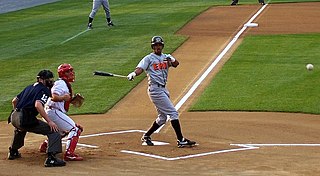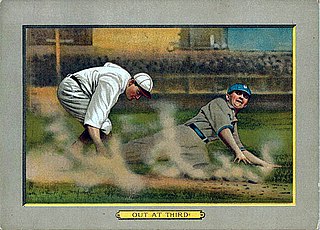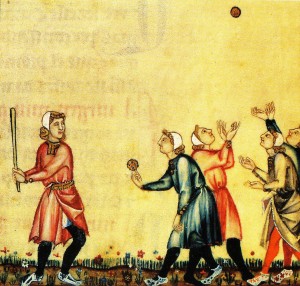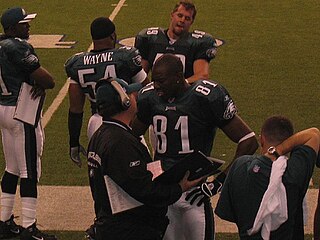
Rounders is a bat-and-ball game played between two teams. Rounders is a striking and fielding team game that involves hitting a small, hard, leather-cased ball with a rounded end wooden, plastic, or metal bat. The players score by running around the four bases on the field.

Softball is a game similar to baseball played with a larger ball on a field that has base lengths of 60 feet, a pitcher's mound that ranges from 35 to 43 feet away from home plate, and a home run fence that is 220–300 feet away from home plate, depending on the type of softball being played. It was invented in 1887 in Chicago, Illinois, United States as an indoor game. The game moves at a faster pace than traditional baseball due to the field being smaller and the bases and the fielders being closer to home plate. There is less time for the base runner to get to first while the opponent fields the ball; yet, the fielder has less time to field the ball while the opponent is running down to first base.

Catcher is a position for a baseball or softball player. When a batter takes their turn to hit, the catcher crouches behind home plate, in front of the (home) umpire, and receives the ball from the pitcher. In addition to this primary duty, the catcher is also called upon to master many other skills in order to field the position well. The role of the catcher is similar to that of the wicket-keeper in cricket, but in cricket, wicketkeepers are increasingly known for their batting abilities.

In baseball, a foul ball is a batted ball that:

In baseball, an out occurs when the umpire rules a batter or baserunner out. When a batter or runner is out, they lose their ability to score a run and must return to the dugout until their next turn at bat. When three outs are recorded in a half-inning, the batting team's turn expires.

The rules of baseball differ slightly from league to league, but in general share the same basic game play.

Cricket and baseball are the best-known members of a family of related bat-and-ball games. Both have fields that are 400 feet (120 m) or more in diameter between their furthest endpoints, offensive players who can hit a thrown ball out of the field and run between safe areas to score runs (points) at the risk of being gotten out, and have a major game format lasting about 3 hours.
In baseball, interference occurs in situations in which a person illegally changes the course of play from what is expected. Interference might be committed by players on the offense, players not currently in the game, catchers, umpires, or spectators. Each type of interference is covered differently by the rules.

Pesäpallo is a fast-moving bat-and-ball sport that is often referred to as the national sport of Finland and has some presence in other countries including Germany, Sweden, Switzerland, Australia, and Canada's northern Ontario. The game is similar to brännboll, rounders, and lapta, as well as baseball.

Over-the-line is a bat-and-ball sport, a game related to baseball and softball. Like those games, you have the batter, pitcher, and fielders. Because a game requires only three people per team, it is considerably easier to get a good informal game going. Equipment consists of a rope, an "official" softball bat & a "official" Orange rubber DeBeer softball. No gloves are allowed while fielding in the Men's divisions unless 60+ years of age. However, gloves are allowed for the women's divisions. Junior events also allow a glove on defense. A single golf glove may be used when batting. Game play, however, is very different.

Bat-and-ball games are field games played by two opposing teams, in which the action starts when the defending team throws a ball at a dedicated player of the attacking team, who tries to hit it with a bat and run between various safe areas in the field to score runs (points), while the defending team can use the ball in various ways against the attacking team's players to force them off the field when they are not in safe zones, and thus prevent them from further scoring. The best known modern bat-and-ball games are cricket and baseball, with common roots in the 18th-century games played in England.

This is an alphabetical list of selected unofficial and specialized terms, phrases, and other jargon used in baseball, along with their definitions, including illustrative examples for many entries.
Pinners is a Chicago neighborhood game played on the front-stoop or walls with angled bricks/stones which can be used to pop the ball up in the air. References and accounts of playing exist to 1949 or earlier. The batter would throw a rubber/tennis ball at the edge of the step or angled wall brick, and the fielder(s) would try to catch the ball as it bounces back. The ball used was a two and a half-inch hollow pink soft rubber ball called a "Pinky," that bounced well off the edges of steps. Baseball gloves were not allowed. The scoring rules is similar to baseball, but with runs being virtual determined by where the ball lands. A single, double, triple or home run would be predetermined landmarks from the batting area. A catch is an out, and a one-handed catch could be used for a "rushie." As with most neighborhood games, rules varied by the groups playing and house rules would be determined at the start of the game, including the base locations. The game utilizes traditional Chicago neighborhood row house architecture, with most houses having front stairs or a stoop that leads from the front door to the sidewalk. Many of the schools built in Chicago have a horizontal perfectly angled section of decorative brick, at the right height, that was used for the game.
Beer-Baseball is a drinking game in which players shoot a ping-pong ball across a table with the intent of landing the ball in one of several cups of beer on the other end, doing so in a way combining beer pong and flip cup. The game typically consists of two teams of even numbers, one on each side of a table, and four cups set up on each side. The cups are lined up in a straight line representing the bases with the last cup at the edge of the table.

In sports, out of bounds refers to being outside the playing boundaries of the field. Due to the chaotic nature of play, it is normal in many sports for players and/or the ball to go out of bounds frequently during a game. The legality of going out of bounds, and the ease of prevention, vary by sport. In some cases, players may intentionally go or send the ball out of bounds when it is to their advantage.











